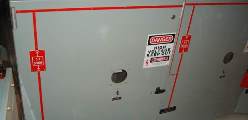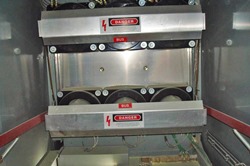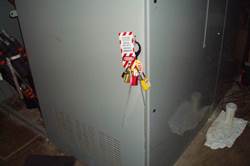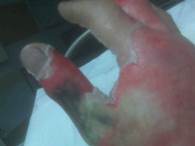
Lockout/Tagout Accident Investigation
We could point to several mistakes that were made in this case, but the root cause does not belong entirely to the worker.
- By James R. White
- Aug 01, 2014
Lockout/tagout was one of the first requirements OSHA mandated, starting in 1990. The electrical lockout/tagout regulation became effective in 1990, as well as part of Subpart S. Lockout/tagout training is conducted ad nauseam in every facility in the United States. All of us in the field have had repeated training on lockout/tagout. Lockout/tagout is often the topic of tailgate meetings and safety briefings. It is probably human nature to hear something so often and from so many sources that we go on autopilot at times. Instead of going through the procedures deliberately, even the best of us may not hit it as hard as we should. The following true case study illustrates this point.
 The project involved maintenance work that was being performed by several contractors at a company’s location in the Midwest (the host). The work involved medium-voltage switchgear in a building and an outside substation. The switchgear was of a standard metal-clad, drawout, vacuum interrupter design and was in excellent condition. As can be seen in Figure 1, the switchgear also was marked with the single-line on the front of the gear.
The project involved maintenance work that was being performed by several contractors at a company’s location in the Midwest (the host). The work involved medium-voltage switchgear in a building and an outside substation. The switchgear was of a standard metal-clad, drawout, vacuum interrupter design and was in excellent condition. As can be seen in Figure 1, the switchgear also was marked with the single-line on the front of the gear.
 The worker involved in the incident was assigned to clean the switchgear and vacuum bottles in a section of equipment that had been properly locked out, tagged out, tested, and grounded. The work on this section of switchgear had been ongoing for a couple of days. One of the other contractors asked the worker to clean and test a circuit breaker cell that was not on the original list of equipment to be maintained. The host company that owned the equipment approved the addition of this circuit breaker cell to the list. The circuit breaker cell was to a bus tie breaker that had been deenergized the evening before but had been returned to service. (See Figure 2.)
The worker involved in the incident was assigned to clean the switchgear and vacuum bottles in a section of equipment that had been properly locked out, tagged out, tested, and grounded. The work on this section of switchgear had been ongoing for a couple of days. One of the other contractors asked the worker to clean and test a circuit breaker cell that was not on the original list of equipment to be maintained. The host company that owned the equipment approved the addition of this circuit breaker cell to the list. The circuit breaker cell was to a bus tie breaker that had been deenergized the evening before but had been returned to service. (See Figure 2.)
 It was believed that it was communicated to all the companies that were considered to be either authorized or affected that the bus tie breaker had been returned to service. Locks, tags, and signage were in place from all parties except the worker who was asked to do the maintenance. Because the company that employed the worker was not scheduled to perform any maintenance on that particular circuit, the company was not perceived to be affected or authorized when the LOTO was performed. The involved worker had completed a Job Safety Analysis (JSA) prior to the start of work that day but did not include the newly added circuit breaker cell, so the backfeed hazard caused by the tie breaker was not addressed. The affected worker did not place his own locks or tags on the switchgear because it was already secured (see Figure 3). The locks and tags were on the back side of the circuit breaker cubicle.
It was believed that it was communicated to all the companies that were considered to be either authorized or affected that the bus tie breaker had been returned to service. Locks, tags, and signage were in place from all parties except the worker who was asked to do the maintenance. Because the company that employed the worker was not scheduled to perform any maintenance on that particular circuit, the company was not perceived to be affected or authorized when the LOTO was performed. The involved worker had completed a Job Safety Analysis (JSA) prior to the start of work that day but did not include the newly added circuit breaker cell, so the backfeed hazard caused by the tie breaker was not addressed. The affected worker did not place his own locks or tags on the switchgear because it was already secured (see Figure 3). The locks and tags were on the back side of the circuit breaker cubicle.
 The worker involved in the incident opened the door on the front of the circuit breaker cell in order to perform the assigned maintenance. He did not test the circuit. The worker knelt down on one knee and manually opened the shutters over the bus stabs. Figure 4 shows the exposed energized bus stabs with the shutters open.
The worker involved in the incident opened the door on the front of the circuit breaker cell in order to perform the assigned maintenance. He did not test the circuit. The worker knelt down on one knee and manually opened the shutters over the bus stabs. Figure 4 shows the exposed energized bus stabs with the shutters open.
As the worker extended his hand to begin cleaning the tie breaker cell, an arc flash and shock to the worker occurred. Other maintenance personnel in the area immediately came to his aid and extinguished the fire on his clothing and called 911. The injured worker was transported to a burn center where he received the appropriate medical attention. The worker survived this incident and received burn injuries to his right hand and a blow-out injury to his knee (Figures 5 and 6). After a fairly long recovery period, this worker should be able to continue on with his life, an option that many people in his situation would not have had under similar circumstances.
 Under similar circumstances, companies have been known to fire employees for violating safety rules. That is one approach. He did not test the circuit prior to working on it. He did not complete a JSA. He did not consider how dangerous working bus tie circuits can be. No arc-flash protective clothing or PPE was worn. We could point to several mistakes that were made, but the root cause does not belong entirely to the worker. There were mistakes made by almost all parties involved. The host company approved the additional cell maintenance without considering all of the consequences. Neither the host nor the contractor requesting the circuit breaker cell be added to the list advised the affected worker that the circuit had been reenergized.
Under similar circumstances, companies have been known to fire employees for violating safety rules. That is one approach. He did not test the circuit prior to working on it. He did not complete a JSA. He did not consider how dangerous working bus tie circuits can be. No arc-flash protective clothing or PPE was worn. We could point to several mistakes that were made, but the root cause does not belong entirely to the worker. There were mistakes made by almost all parties involved. The host company approved the additional cell maintenance without considering all of the consequences. Neither the host nor the contractor requesting the circuit breaker cell be added to the list advised the affected worker that the circuit had been reenergized.
Summary
 When I was in boot camp, our drill instructor told us that assume makes an ass out of u and me. It was true then, and it is true today. In this instance, assumptions came into play several times, both by the worker and by the companies involved. The good news is that it did not result in a fatality, but that does not relieve the pain and suffering that the employee had to endure. This same type of scenario is likely repeated at many job sites throughout the United States. Multiple contractors, dozens--maybe hundreds--of workers, power system equipment and devices; all of these have to be taken into consideration when performing maintenance activities. It can become a blur.
When I was in boot camp, our drill instructor told us that assume makes an ass out of u and me. It was true then, and it is true today. In this instance, assumptions came into play several times, both by the worker and by the companies involved. The good news is that it did not result in a fatality, but that does not relieve the pain and suffering that the employee had to endure. This same type of scenario is likely repeated at many job sites throughout the United States. Multiple contractors, dozens--maybe hundreds--of workers, power system equipment and devices; all of these have to be taken into consideration when performing maintenance activities. It can become a blur.
People are people, and people make mistakes. That is why we have OSHA regulations, NFPA 70E, company procedures, policies, etc. Most if not all of us have either been involved in accidents or know people who have been. It's not like it's a secret that people make mistakes, but to talk to some and they seem to think only others have that failing.
Safety is not about just any one procedure or rule. It's about slowing down, making a plan, and executing that plan. There are plenty of tools available to help us: policies, procedures, codes, standards, federal regulations, and state and local laws. I am not about to say that the worker involved in this incident was not taking safety seriously, but he failed to follow some fundamental safety rules like test-before-touch. If he had taken just that one step, there would be nothing to write about.
This article originally appeared in the August 2014 issue of Occupational Health & Safety.